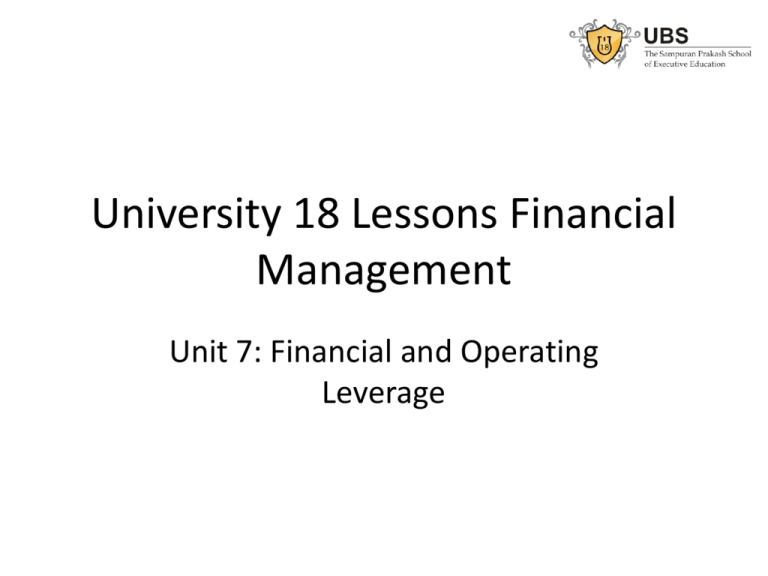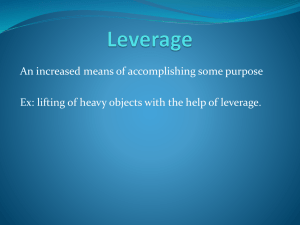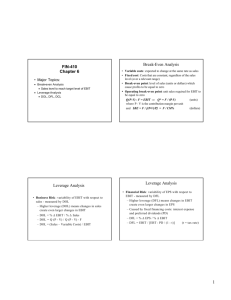financial leverage
advertisement

University 18 Lessons Financial Management Unit 7: Financial and Operating Leverage Approaches to Determine Appropriate Capital Structure What is Capital Structure • The term capital structure is used to represent the proportionate relationship between debt and equity. • The various means of financing represent the financial structure of an enterprise. The left-hand side of the balance sheet (liabilities plus equity) represents the financial structure of a company. Traditionally, short-term borrowings are excluded from the list of methods of financing the firm’s capital expenditure. Capital Structure Decision • In theory there is an optimal capital structure which depends on the tax advantage of debt, the financial distress costs and agency costs associated with debt, and the degree of informational asymmetry. • How can the optimal capital structure be determined in practice? • There does not appear to be any single method. Different types of analysis include: • EBIT-EPS analysis • ROI-ROE analysis • Ratio analysis • Cash flow analysis to assess firm’s debt servicing ability EBIT-EPS analysis • In general, the relationship between EBIT and EPS is as follows: (EBIT – I) (1 – t) • EPS = ------------------------ , where n EPS = earning per share EBIT = earnings before interest and taxes I = interest burden t = tax rate n = number of equity shares Example: EBIT-EPS analysis • ABC Limited has an existing capital structure of 1 million shares of Rs.10 each and is subject to a tax rate of 50%. • ABC Limited plans to raise additional capital of Rs.10 million for financing an expansion project. • In this context ABC Limited is evaluating two alternative financing plans: (i) issue of equity shares (1 million equity shares of Rs.10 per share), and (ii) issue of debentures carrying 14% interest. • What will be the EPS under the two alternative financing plans for two levels of EBIT, say Rs.4 million and Rs.2 million? Example: EBIT-EPS analysis Equity Financing Debt Financing EBIT: 2,000,000 EBIT: 4,000,000 Interest EBIT: 2,000,000 EBIT: 4,000,000 1,400,000 1,400,000 - - Profit before taxes 2,000,000 4,000,000 600,000 2,600,000 Taxes 1,000,000 2,000,000 300,000 1,300,000 Profit after tax 1,000,000 2,000,000 300,000 1,300,000 No. of equity shares 2,000,000 2,000,000 1,000,000 1,000,000 0.50 1.00 0.30 1.30 EPS Break-even EBIT Level or Indifference Point • The EBIT indifference point between the two alternative plans can be obtained by solving the following equation for EBIT: (EBIT* - I1)(1-t) (EBIT* - I2)(1-t) --------------------- = --------------------- . Taking the ABC case n1 n2 (EBIT* - 0)(0.5) (EBIT* - 1,400,000)(0.5) --------------------- = -------------------------------2,000,000 1,000,000 Or EBIT* = Rs. 2,800,000 This break-even level of EBIT at Rs.2.80 million means that if EBIT is below Rs.2.8 million, equity financing is preferable to debenture financing; while if EBIT is higher than Rs.2.8 million, then it is the other way around. ROI-ROE Analysis • We now look at the relationship between return on investment (ROI) and return on equity (ROE) at different levels of financial leverage. • Suppose a firm, which requires an investment outlay of Rs.100 million, is considering two capital structures: Capital Structure A (only funded by Equity of Rs.100 million), and Structure B (funded by Equity of Rs.50 million and Debt of Rs.50 million). • While the average cost of debt is fixed (say 10%), the ROI (as defined by EBIT divided by total assets) may vary widely. ROI-ROE Analysis Rs. In million Capital Structure A Capital Structure B ROI 5% 10% 15% 20% 25% 5% 10% 15% 20% 25% EBIT 5 10 15 20 25 5 10 15 20 25 Interest 0 0 0 0 0 5 5 5 5 5 Profit Before Tax 5 10 15 20 25 0 5 10 15 20 Tax (50%) 2.5 5 7.5 10 12.5 0 2.5 5 7.5 10 Profit After Tax 2.5 5 7.5 10 12.5 0 2.5 5 7.5 10 Return of Equity 2.5% 5% 7.5% 10% 12.5% 0% 5% 10% 15% 20% ROI-ROE Analysis • The ROE under capital structure A is higher than the ROE under capital structure B when ROI is less than the cost of debt • The ROE under the two capital structures is the same when ROI is equal to the cost of debt. Hence the indifference (or break-even) value of ROI is equal to the cost of debt. • The ROE under capital structure B is higher than the ROE under capital structure A when ROI is more than the cost of debt. Effect of Leverage on ROE and EPS Favourable ROI > i Unfavourable ROI < i Neutral ROI = i Financial & Operating Leverage Operating Leverage • The operating costs are categorised into three: • One - fixed costs, which do not vary with the level of production, they must be paid regardless of the amount of revenue available. Example, depreciation of plant and machinery, buildings, insurance • Second - variable costs that varies directly with the level of production. Example, raw materials, direct labour costs, etc. • Third - Semi-variable costs, which partly vary and is partly fixed. Operating Leverage • Operating Leverage is present at any time. This is because a firm has operating costs regardless of the level of production. These fixed costs do not vary with sales. They must be paid regardless of the amount of revenue available. • Hence, operating leverage may be defined as the firm's ability to use operating costs to magnify the effects of changes in sales on its earnings before interest and taxes. • Operating leverage is associated with investment (assets acquisition) activities. Hence, operating leverage results from the present fixed operating expenses within firm's income stream. Operating Leverage Operating Leverage • Illustration : XYZ Ltd., produced and sold 1,00,000 units of a product at the rate of Rs.100. For production of 1,00,000 units, it has spend a variable cost of Rs. 6,00,000 at the rate of Rs. 6 per unit and a fixed cost of Rs. 2,50,000. The firm has paid interest Rs. 50,000 at the rate of 5 per cent and Rs. 10,00,000 debt. Calculate operating leverage. Operating Leverage Operating Leverage Operating Leverage Financial Leverage • A firm needs long-term funds for long-term activities like expansion, diversification, modernization etc. The required funds may be raised by two sources: equity and debt. Use of various sources to compose capital is known as financial structure. The use of fixed charges, sources of funds such as debt and preference share capital, along with the equity share capital in capital structure is described as financial leverage. • Financial leverage is the ability of the firm to use fixed financial charges to magnify the effects of changes in EBIT on the firm's earnings per share. In other words, financial leverage may be defined as the payment of fixed rate of interest for the use of fixed interest bearing securities, to magnify the rate of return on equity shares. It is also known as "trading on equity". Financial Leverage • Hence, financial leverage results from the presence of fixed financial charges in the income statement. Financial leverage is associated with financing activities. The fixed charges do not vary with firm's EBIT. They must be paid regardless of the amount of EBIT available to the firm. It indicates the effect on EBIT created by the use of fixed charge securities in the capital structure of a firm. • Financial leverage is computed by the following formula: Financial Leverage Financial Leverage • A Financial leverage may be positive or negative. Favourable leverage occurs when the firm earns more on the assets purchased with the funds, than the fixed cost of their use and vice versa. • High degree of financial leverage leads to high financial risk. The financial risk refers to the risk of the firm not being able to cover its fixed financial costs. • Hence, the financial manager should take into consideration, the level of EBIT and fixed charges while preparing the firm's financial plan. Financial Leverage • Illustration: A firm has sales of 1,00,000 units at Rs. 10 per unit. Variable cost of the produced products is 60 per cent of the total sales revenue. Fixed cost is Rs. 2,00,000. The firm has used a debt of Rs. 5,00,000 at 20 per cent interest. Calculate the operating leverage and financial leverage. • Operating leverage = Contribution/ EBIT = 4,00,000/ 2,00,000 = 2 • Financial leverage = EBIT/EBT = 2,00,000/ 1,00,000 = 2 Financial Leverage Combining Financial and Operating Leverages • Operating leverage affects a firm’s operating profit (EBIT), while financial leverage affects profit after tax or the earnings per share. • The degrees of operating and financial leverages is combined to see the effect of total leverage on EPS associated with a given change in sales. Combining Financial and Operating Leverages • The degree of combined leverage (DCL) is given by the following equation: Combining Financial and Operating Leverages • The combined leverage can work in both directions. It is favourable if sales increase and unfavourable when sales decrease. This is because the change in sales results in more than proportionate returns in the form of EPS. Financial leverage and operating leverage are something like a doubleedged sword. They have tremendous acceleration or deceleration effects on EBIT and EPS. • Illustration: VST Corporation has sales of Rs. 40 lakh, variable cost is 70 per cent of the sales and fixed cost is Rs.8,00,000. The firm has raised Rs.20 lakh funds by issue of debentures at the rate of 10 per cent. Compute operating, financial and combined leverages. Combining Financial and Operating Leverages Combining Financial and Operating Leverages • Illustration: From the following particulars of PQR Company, calculate operating and financial leverages. The company's current sales revenue is Rs. 15,00,000 lakh and sales are expected to increase by 25 per cent. Rs. 9,00,000 is incurred on variable expenses for generating Rs.15 lakh sales revenue. The fixed cost is Rs. 2,50,000. The company has Rs. 20 lakh equity shares capital and Rs. 20 lakh, 10 per cent debt capital. Calculate operating leverage and financial leverage. Each equity share is of Rs. 10 face value and 50 per cent tax rate. • Ans: A % change in EPS is 100% while % change in sales is 25%, the combined leverage is 4. Combining Financial and Operating Leverages





